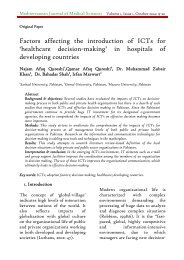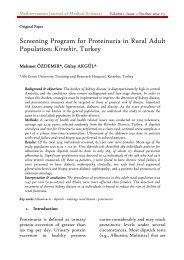Assessment Of Nutritionnal Status Of Hiv Infected And Hiv Negative Pregnant Women In Ngaoundere, Cameroon
Background & objectives: Malnutrition (underfeeding) can affect the treatment of AIDS in that it reduces the ability of the intestine to absorb drugs, organic substances and micronutrients. Underfeeding could also increase the chances of transmission of the disease from an infected mother to the baby during pregnancy. The objective of this study is to compare the energy intake, weigh rate and nutritional status between the HIV and non HIV pregnant women attending two referrals hospitals in Ngaoundere (Cameroon). Methods:A cross sectional study using 24-hour dietary recall was applied to a sample of 109 women, randomly selected from a population-based and anthropometric data were done. Results: Result show that HIV negative pregnant women consumed less energy intake per day than the HIV infected pregnant women at all age groups with no significant difference (Fcal=1.19, p=0.317). Gain in weight between the HIV infected and HIV negative pregnant women in relation to their various age groups was no significant (F= 1.23, p=0.27). There was no significant influence of HIV status in pregnant women BMI (F=2 29, p=0.133). Interpretation & conclusion:In this study, the higher consumption of energy by HIV infected pregnant women than HIV negative women could be because HIV infected pregnant women were at the beginning of the infection which has not yet affected the immune system. In the two referral hospital of Ngaoundere besides HIV screening tests, should be also nutritional services to advice these women on their nutritional habits. Keywords: Malnutrition, Body mass Index, HIV/AIDS, energy consumption
Background & objectives: Malnutrition (underfeeding) can affect the treatment of AIDS in
that it reduces the ability of the intestine to absorb drugs, organic substances and
micronutrients. Underfeeding could also increase the chances of transmission of the disease
from an infected mother to the baby during pregnancy. The objective of this study is to
compare the energy intake, weigh rate and nutritional status between the HIV and non HIV
pregnant women attending two referrals hospitals in Ngaoundere (Cameroon).
Methods:A cross sectional study using 24-hour dietary recall was applied to a sample of 109
women, randomly selected from a population-based and anthropometric data were done.
Results: Result show that HIV negative pregnant women consumed less energy intake per
day than the HIV infected pregnant women at all age groups with no significant difference
(Fcal=1.19, p=0.317). Gain in weight between the HIV infected and HIV negative pregnant
women in relation to their various age groups was no significant (F= 1.23, p=0.27). There was
no significant influence of HIV status in pregnant women BMI (F=2 29, p=0.133).
Interpretation & conclusion:In this study, the higher consumption of energy by HIV infected
pregnant women than HIV negative women could be because HIV infected pregnant women
were at the beginning of the infection which has not yet affected the immune system. In the
two referral hospital of Ngaoundere besides HIV screening tests, should be also nutritional
services to advice these women on their nutritional habits.
Keywords: Malnutrition, Body mass Index, HIV/AIDS, energy consumption
Create successful ePaper yourself
Turn your PDF publications into a flip-book with our unique Google optimized e-Paper software.
Mediterranean Journal of Medical Sciences V1, I1 October 2014: 21-30 22<br />
has ravaged sub-Sahara Africa for<br />
decades and is still a major cause<br />
of adult morbidity and mortality<br />
(Masanjala, 2007). Recent<br />
estimates by the World Health<br />
Organization (WHO) show that<br />
about 33.3 million people are living<br />
with HIV/AIDS worldwide with<br />
22.5 million living in sub-Saharan<br />
Africa (Global Report, 2010). The<br />
prevalence in <strong>Cameroon</strong> stands at<br />
5.5 % with the Adamawa region<br />
occupying the 5 th position with 6.9<br />
% (Comité National de Lutte<br />
contre le Sida, 2004).<br />
Studies outlined that there<br />
is a relationship between<br />
malnutrition and AIDS (AIDS<br />
institute, 1995). Research shows<br />
that, the chance of infection with<br />
the HIV virus might be reduced<br />
in individuals who have good<br />
nutritional status with<br />
micronutrients and especially,<br />
vitamin A playing significant<br />
roles (ACC, 1998). Malnutrition<br />
(underfeeding) can affect the<br />
treatment of AIDS in that it<br />
reduces the ability of the<br />
intestines to absorb drugs, organic<br />
substances and micronutrients.<br />
Underfeeding could also increase<br />
the chances of transmission of the<br />
disease from an infected mother<br />
to the baby during pregnancy<br />
(Semba, 1997).<br />
This affirmation thus necessitates<br />
certain questions on the<br />
increasing rate of HIV positives<br />
in this region of the world, which<br />
is one of the most affected<br />
(CNLS, 2004). One would<br />
therefore be tempted to believe<br />
that underfeeding plays an<br />
important role in increasing the<br />
damaging effects of the<br />
HIV/AIDS. <strong>In</strong> the town of<br />
<strong>Ngaoundere</strong>, there is a dearth of<br />
informations on the relationship<br />
between underfeeding and<br />
HIV/AIDS. Thus, this study was<br />
undertaken to compare the energy<br />
intake, weight rate and nutritional<br />
status between the HIV and non-<br />
HIV pregnant women attending<br />
two referrals hospitals in<br />
<strong>Ngaoundere</strong>, <strong>Cameroon</strong>.<br />
2. Materials <strong>And</strong> Methods<br />
Study Area<br />
<strong>Ngaoundere</strong> is the capital city of<br />
the Adamawa Region, <strong>Cameroon</strong>.<br />
The city is located at latitude<br />
7 0 .19’N and longitude 13 0 34’E. Its<br />
population was estimated at<br />
about 230,000 inhabitants in 2001<br />
(Tchotsoua, 2006).The Adamaoua<br />
region is high in altitude; its<br />
whether is between 22 and 25 0 .<br />
This plateau contains 2 types of<br />
climates: the Sudanese type of<br />
tropical climate and the<br />
<strong>Cameroon</strong> type of equatorial<br />
climate. The Sudanese type of<br />
tropical climate has a dry season<br />
covering the period of November<br />
to March; then comes the moist<br />
season with down falls ranging<br />
from 900 mm to 1500mm. The<br />
©2014 Mediterranean Center of Medical Sciences








